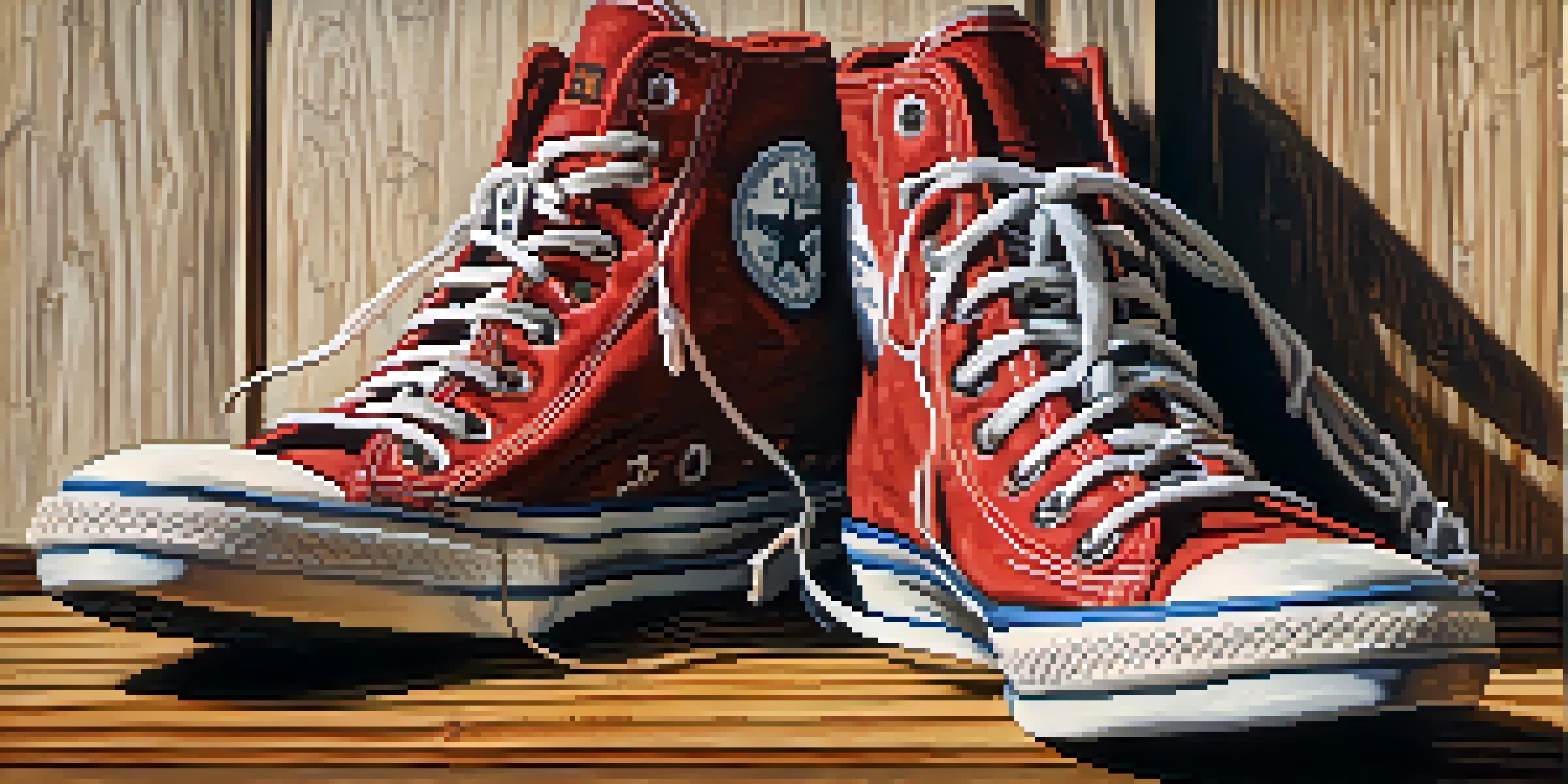The Evolution of Sneakers: From Sports to Fashion Icons

The Origins of Sneakers: A Humble Beginning
Sneakers have come a long way since their inception in the late 1800s. Originally, they were designed for comfort, made with rubber soles for better grip and flexibility. The first sneakers, often called 'plimsolls,' were primarily used for sports and physical activities, providing an alternative to heavy leather shoes.
Sneakers are not just footwear; they are a means of self-expression.
As the 20th century approached, brands like Keds and Converse began to produce shoes that appealed to a broader audience, including children and young adults. These shoes were not just functional; they started to reflect a sense of leisure and lifestyle. The iconic Converse Chuck Taylor All-Stars, introduced in 1917, became a staple for basketball players and eventually transcended into casual wear.
This shift set the stage for sneakers to evolve further, paving the way for their eventual rise as cultural symbols that blended functionality with style.
The Rise of Athletic Brands in the Mid-20th Century
The mid-20th century marked a significant turning point for sneaker culture, with brands like Nike, Adidas, and Puma emerging as household names. These companies began to invest heavily in technology and design, creating shoes that not only enhanced performance but also appealed to the fashion-conscious consumer. For example, Nike's Air technology introduced in the late 1970s revolutionized cushioning in sports shoes.

As professional athletes endorsed these brands, sneakers gained credibility and desirability. Icons like Michael Jordan and his partnership with Nike in the 1980s birthed the Air Jordan line, which blurred the lines between athletic wear and high fashion. Suddenly, sneakers were not just for playing sports; they became status symbols.
Sneakers Evolved from Function to Fashion
Originally designed for sports, sneakers have transformed into cultural symbols and fashion statements over the years.
This era solidified the sneaker's place in popular culture, attracting attention from various demographics and setting the foundation for future styles.
Sneakers in Pop Culture: A Fashion Revolution
As the 1990s rolled around, sneakers began to infiltrate pop culture on a grand scale. Hip-hop artists and celebrities embraced sneakers, often showcasing them in music videos and on red carpets. This shift made sneakers a crucial part of streetwear, with brands releasing limited editions that sparked frenzy among fans and collectors alike.
Fashion is not something that exists in dresses only. Fashion is in the sky, in the street, fashion has to do with ideas, the way we live, what is happening.
Additionally, movies like 'Back to the Future' and 'Do the Right Thing' featured iconic sneakers, further embedding them into the cultural fabric. The 'Air Mag' from 'Back to the Future Part II' is a perfect example of how sneakers can transcend their original purpose and become part of a larger narrative.
This era cemented sneakers as more than just footwear; they became a form of self-expression and identity.
The Sneakerhead Phenomenon: Collecting and Culture
With the rise of sneaker culture came the emergence of the 'sneakerhead' phenomenon. Sneakerheads are enthusiasts who collect, trade, and obsess over rare and limited-edition sneakers. This culture not only celebrates the artistry of sneaker design but also the thrill of the hunt for that elusive pair.
Websites and apps dedicated to sneaker releases and reselling, like StockX and GOAT, gained popularity, creating a marketplace where prices can soar to astronomical heights. The demand for exclusive collaborations, such as those between Adidas and Kanye West for the Yeezy line, has made collecting sneakers akin to investing in art.
Sneaker Culture Drives Collecting Trends
The rise of the 'sneakerhead' phenomenon highlights the excitement of collecting rare sneakers, turning them into a form of cultural currency.
This trend showcases how sneakers have evolved into a cultural currency, connecting people and communities through a shared passion.
Sustainability in Sneaker Design: A New Era
As awareness of environmental issues grows, the sneaker industry is responding with a focus on sustainability. Many brands are now exploring eco-friendly materials and production methods to minimize their carbon footprint. For instance, companies like Allbirds and Veja emphasize using natural and recycled materials in their sneaker designs.
This shift is not just about being trendy; it reflects a broader societal call for responsibility and ethics in fashion. Consumers are becoming more conscious of their purchases, leading brands to innovate and prioritize sustainability in their product lines.
As this movement continues, it may redefine the sneaker landscape, blending style with a commitment to the planet.
The Intersection of Technology and Sneakers
In recent years, technology has begun to play a significant role in the evolution of sneakers. Smart sneakers equipped with fitness tracking, adaptive fitting, and even self-lacing mechanisms are becoming increasingly popular. Brands like Nike have introduced models that integrate technology to enhance both performance and comfort.
This fusion of fashion and function is particularly appealing to the tech-savvy generation. Imagine a sneaker that not only looks good but also monitors your activity levels and adjusts to your foot shape for optimal comfort.
Sustainability Shapes Sneaker Design
Increasing environmental awareness is pushing sneaker brands to adopt sustainable materials and practices in their designs.
As technology continues to advance, the future of sneakers is likely to be filled with innovations that elevate the user experience while maintaining style.
Sneakers: From the Court to the Catwalk
Today, sneakers have firmly established their place in high fashion, often gracing the runways of major fashion weeks. Designers like Balenciaga and Gucci have embraced the sneaker trend, creating bold and extravagant designs that challenge traditional notions of luxury footwear. This evolution signifies a cultural shift where comfort and style coexist.
Collaborations between high-end designers and sneaker brands have also become a common phenomenon, resulting in unique, limited-edition pieces that attract fashion enthusiasts and collectors alike. The blending of streetwear with high fashion reflects a broader acceptance of casual wear in formal settings.

Ultimately, sneakers have transcended their original purpose, transforming into versatile fashion icons that cater to diverse tastes and lifestyles.